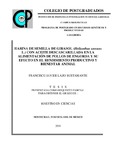Harina de semilla de girasol (Helianthus annuus L.) con aceite descascarillada en la alimentación de pollos de engorda y su efecto en el rendimiento productivo y bienestar animal.
Abstract
Se evaluó la inclusión de harina de semilla de girasol con aceite descascarillada (HSGAD) como sustituto parcial de la pasta de soya y como sustituto del aceite crudo de soya (ACS) en las variables productivas, variables de bienestar animal y características de la canal de pollos de engorda machos Ross 308 (n= 280). Se utilizaron criadoras eléctricas en la etapa de iniciación (1-21 días de edad) en criadoras eléctricas y finalizados en piso (22-49 días de edad). Se evaluaron cuatro dietas (tratamientos) isoenergéticas e isoproteinicas a base de pasta de soya y sorgo molido; testigo T1, sin HSGAD; T2, con 5% de inclusión HSGAD y ACS; T3, con 10% de HSGAD sin ACS y T4, con 5% de HSGAD sin ACS. Los resultados mostraron únicamente diferencias entre los tratamientos T1 y T4 (p < 0.05) para las variables productivas. Entre los tratamientos con HSGAD no se encontraron diferencias (p > 0.05). En las variables relacionadas con el bienestar animal no se observaron diferencias entre tratamientos, pero el peso y el rendimiento de la canal fueron mayores en T1, mostrando sólo diferencias con T4; la pigmentación de la piel de la pechuga fue similar en todos los tratamientos. _______________ SUNFLOWER SEED FLOUR DISCHARGED IN FEEDING CHICKENS. ABSTRACT: The inclusion of sunflower seed meal with peeled oil (HSGAD) as a partial substitute for soybean meal and as a substitute for crude soybean oil (SCA) in the productive variables, animal welfare variables and carcass characteristics was evaluated on broilers chickens Ross 308 (n = 280). Electric brooders were used in the initiation stage (1-21 days of age) in electric brooders and finished on the floor (22-49 days of age). Four diets (treatments) isoenergetic and isoproteinic based on soybean paste and ground sorghum were evaluated; T1 control, without HSGAD; T2, with 5% inclusion HSGAD and ACS; T3, with 10% of HSGAD without ACS and T4, with 5% of HSGAD without ACS. The results showed only differences between the treatments T1 and T4 (p <0.05) for the productive variables. Among the treatments with HSGAD, no differences were found (p> 0.05). In the variables related to animal welfare, no differences were observed between treatments, but the weight and yield of the carcass were higher in T1, showing only differences with T4; the skin pigmentation of the breast was similar in all treatments.
Collections
- Tesis MC, MT, MP y DC [403]


